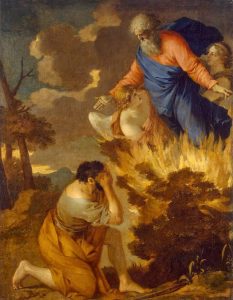
The Living God and the God of the Philosophers
Part 1: A Tension
When it comes thinking about God, there is a tension that inevitable arises. The tension is sometimes casts in terms of the differing conceptions of God that result when one looks to first to Scripture and secondly to philosophy.
You can hear a little bit of the tension in this wonderful section in John Mark Comer’s recent book Practicing the Way. Comer writes,
God is not a concept or emotion, and he’s certainly not a doctrine in a statement of faith or a chapter in a theology book; he is a person, whose burning desire is to know and be known by you. And like in any intimate relationship, there is a kind of knowledge that goes beyond words—a kind you can get only by direct person-to-person experience.[1]
Or consider the claim of my colleague at Palm Beach Atlantic University, Dr. Paul Copan, who writes in his book Loving Wisdom,
The triune God isn’t the static, untouchable deity commonly associated with traditional Greek philosophy. He’s a prayer-answering, history-engaging God.[2]
So, the tension is between the God of Scriptures, portrayed as alive and relational and responsive to humans and the God of the philosophers, portrayed as distant, aloof, the ultimate source of all being and the dominant (or sole) actor on the stage of history.
Part 2: The God of the Philosophers
Of course, there isn’t one model, but rather, many models of God when we speak of the God of the philosophers. To vastly simplify the debate over models of God, I’ll mention three models of God that count as a “God of the philosophers.”[3]
First, there is classical theism. This is the model of God held by many theologians over the first 1,500 years of the church, including Augustine, Anslem, and Aquinas to just name the “A-team.” This is the God of Greek philosophy that Copan has in mind in his comment. The God of classical theism has all the omni-properties we’ve discussed this season: omnipotence, omnipresence, omniscience, omnibenevolence. God exists necessarily and self-sufficiently. The four characteristic doctrines of classical theism that are unique to the model are divine simplicity, divine timelessness, strong or strict immutability, and strong or strict impassibility.
Second, as a point of contrast with classical theism, there is process theism. In many ways, process theism can be thought of as the opposite (or near opposite to classical theism). God is completely immanent, always changing, dependent on the world, temporal, eminently passible, and powerful but not all-powerful, knowing but not all-knowing, and thus, not completely sovereign either.
Third, and in-between classical theism and process theism, there is what is sometimes called neo-classical theism (or moderate classical theism, according to John Peckham).[4] The model of God that we’ve been working toward and advocating this season falls in this category. The God of neo-Classical Theism shares with classical theism all the omni-properties, necessary existence, divine aseity, and more. Where the neo-classical theist differs is with respect to four doctrines. Instead of divine simplicity, God is divine unity. Instead of divine timelessness, God is temporal. Instead of strict or strong immutability, God is immutable in his essence but really changes in response to creatures, and instead of divine impassibility, God has a rich and diverse emotional life and is affected by creaturely actions.
Part 3: The God of Scripture
So, if we are going to find a way to bring the so-called God of the philosophers into agreement with the God of Scripture, we need to also determine what is meant, as John Peckham notes, by the phrase the “God of Scripture.”[5] Peckham specifies two stages of inquiry when trying to accurately discern what God is like as portrayed in Scripture.[6] First, we need to carefully identify what the texts says about God (i.e., what is the biblical claims made about God? Secondly, we seek to interpret correctly the biblical data about God.
Given this method, (I’m going to say something possibly controversial) there is a strong initial case for the neo-classical model of God. As Peckham notes, in Scripture, God is clearly portrayed as engaging in “various kinds of back-and-forth relationships with creatures wherein God makes and keeps commitments and is responsive to creatures.”[7] So for example, God is portrayed in Scripture as creating, sustaining, speaking, hearing, providing, seeing, knowing, calling, judging, acting, loving, grieving, suffering, lamenting, promising, defeating evil, and dwelling with us, to name a few. All of this strongly points against the classical model, although it is possible in each case, to argue that such language about God is simply accommodative language to reveal some truth about God without literally ascribing give-and-take relating to God.
So, our question is, how do we decide?
Part 4: A Resolution
We begin with a rule or principle, then a theory about system or model building, and then offer a methodology.
First, here is a fundamental or axiomatic rule or principle we should adopt when thinking about God. Simply stated, it is the conviction that Scripture is the final norm of theological interpretation. In theology, Scripture is understood as the norma normans (“the rule that rules”), which serves to regulate the other sources for doing theology. As Peckham describes it, the idea is that “the Scripture rules, rules as a whole, and rules because it is commissioned to rule by the Ruler himself.”[8]
Second, it is important to realize that in model building, there are three inter-related levels to consider. Peckham puts it this way.[9] There is the bottom level where we seek to faithfully interpret individual texts and passages. Second, there is the middle level, where we seek to incorporate the individual texts and passages into our theological framework, and finally, there is the top level where we seek to incorporate the Biblical and theological data into an overall philosophical framework. Notice the rhythm (which should be a familiar rhythm from our discussions this season): we begin with Scripture, move to theology, and then philosophy as we seek an adequate model of God.
Finally, I think that we should adopt three anchor points when it comes to thinking about God.
Divine ultimacy. This is a conviction that I believe is a deliverance of both sound philosophy and Scripture. God is the sole ultimate reality, and this anchor point should ground all our thinking about God. We find, for example, given this anchor point alone reason to reject process theism.
“bottom-up-ism” – this is the claim that in thinking about God, we ought to be begin with Scripture. Individual verses, groups of verses, the Bible as a whole, and we build “up to” our model of God from the bottom, as it were. Notice, given this starting point, when we try and figure out whether each biblical data point regarding God should be understood in terms of divine accommodation or not, we consider each passage on a case-by-case basis.[10] This is a helpful guard against simply reading our metaphysic back into Scripture.
“inside-out-ism.” This is a claim about the role of the church creeds that have been passed down to us from history. The idea is that we begin “inside” the Christian tradition and then work our way out, always considering (and taking seriously) the claims found in the creeds, but submitting them, as we ought, to the claims of Scripture. Scripture is our rule, not the creeds, but we do give them weight in theological formulation.
Part 5: A Result: Doxology
So, finally, as we end this season, I want to remind us of our familiar rhythm. When it comes to thinking about God, our rhythm is theology, philosophy and then doxology. As we come to truly know and love God we are moved to worship.
Instagram: mere.creativity
Web: merecreativity.org
[1] John Mark Comer, Practicing the Way (Colorado Springs, CO: WaterBrook, 2024), 51.
[2] Paul Copan, Loving Wisdom, 2nd ed. (Grand Rapids, MI: Eerdmans, 2020), 94; quoted in John C. Peckham, Divine Attributes: Knowing the Covenantal God of Scripture (Grand Rapids, MI: Baker, 2021), 23–24.
[3] There are more, of course. I’m following the nice taxonomy as discussed by Peckham, Divine Attributes, 20–23.
[4] Ibid., 22.
[5] Peckham, Divine Attributes, 27.
[6] Ibid., 27–29.
[7] Ibid., 28.
[8] Peckham, Divine Attributes, 29 FN 49.
[9] Ibid., 31.
[10] Ibid., 35.




